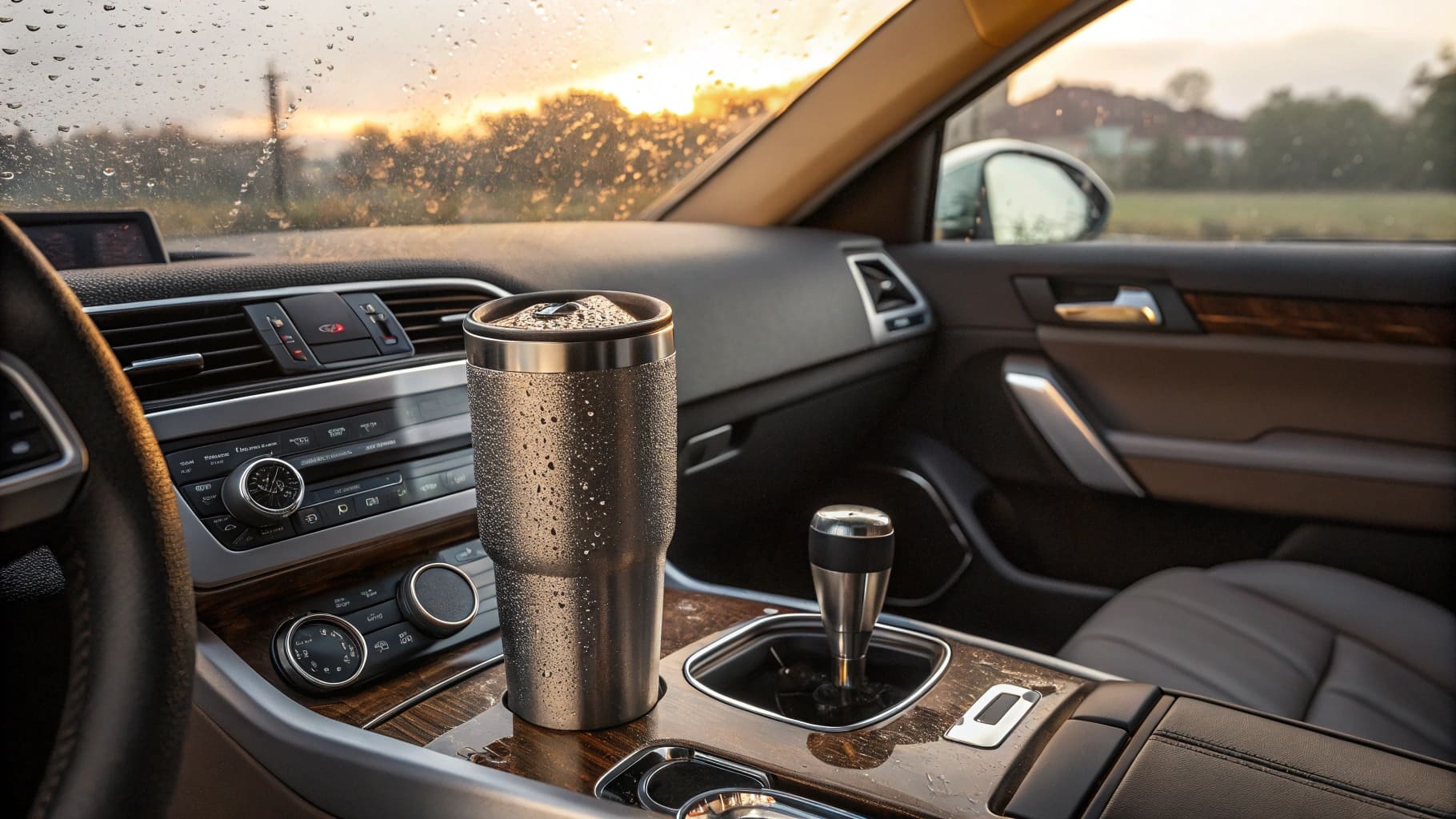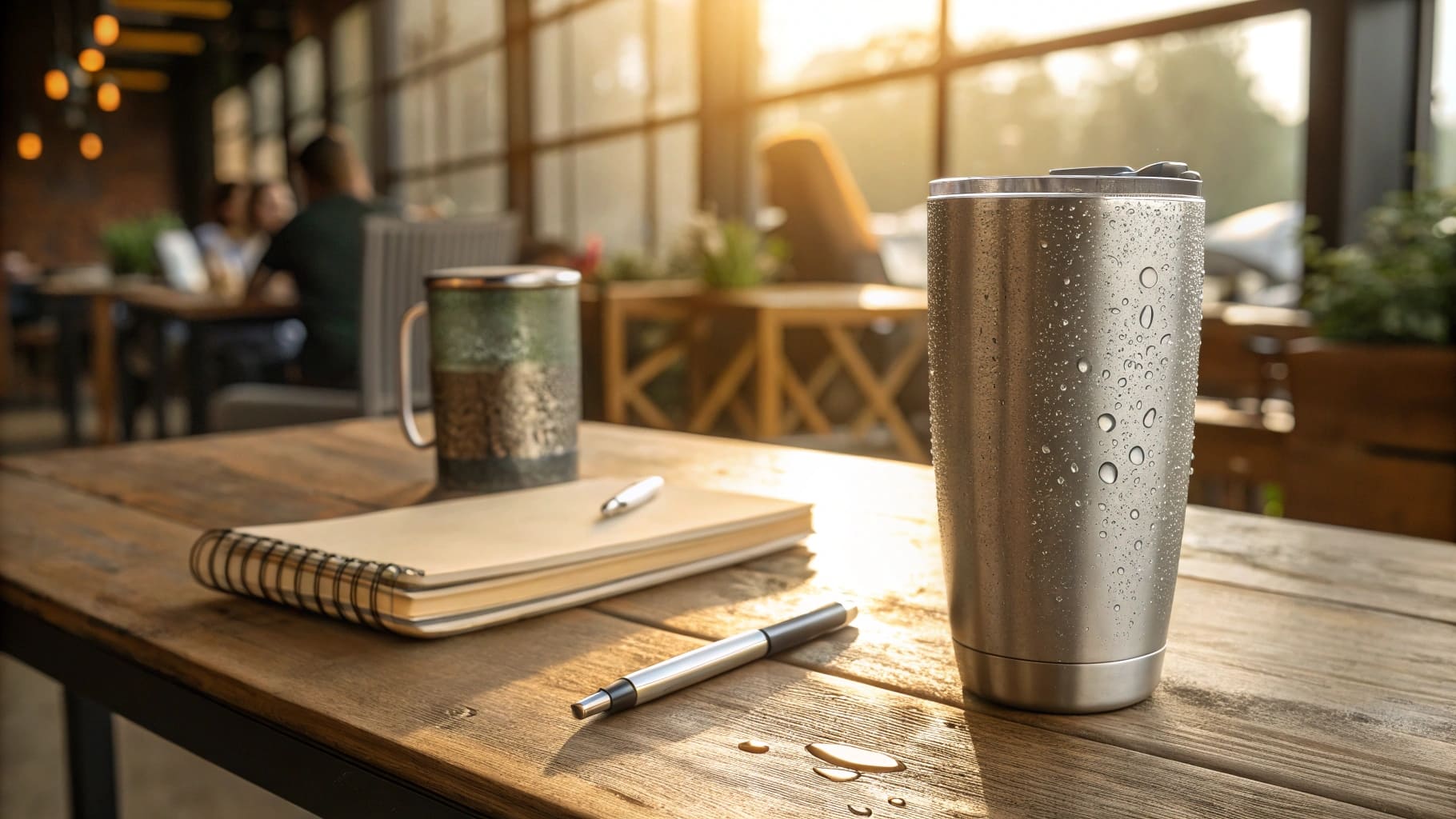Your brand wants to show it cares about the planet. But choosing the right products feels confusing. Stainless steel provides a simple, powerful solution customers trust.
Stainless steel cups are a top choice because of their extreme durability and high recyclability. Their long lifespan replaces countless single-use items, drastically cutting down waste. This makes them a credible, genuinely sustainable product for environmentally-conscious brands.

This combination of strength and recyclability is key. But it's the reusability that truly makes the biggest difference for the environment. It shifts the focus from disposal to long-term value. This is a powerful story for any brand to tell. Let's look closer at why this matters for your business and what makes these cups stand out from other options.
What is the Most Eco-Friendly Cup Material?
You see "eco-friendly" everywhere, but what does it really mean for a cup? It's confusing to navigate the claims. We can help you find a material that is genuinely sustainable.
The most eco-friendly cup material is one that balances durability, recyclability, and a low environmental impact over its entire life. Stainless steel excels here because its reusability dramatically reduces the need for single-use cups, making it a top contender.

When I talk to clients, like Mark from Canada, this is a frequent topic. He's a business owner who buys products to rebrand and sell. He told me, "Aries, I've seen it all. Bamboo cups that aren't fully biodegradable, plastic cups marketed as 'green.' I need something that my customers can use for years, not just something that sounds good." His point is crucial. True eco-friendliness isn't just about the end-of-life plan; it's about the entire lifecycle. We need to compare materials honestly.
Material Lifespan Comparison
Let's look at how different materials hold up over time. A longer life means less waste.
| Material | Typical Lifespan | Key Weakness |
|---|---|---|
| Stainless Steel | 10+ years | Can dent if dropped hard |
| Glass | Years (if not broken) | Very fragile, easily shatters |
| Reusable Plastic | 1-5 years | Can stain, absorb odors, degrade |
| Bamboo Fiber | 1-3 years | Can crack, not dishwasher safe |
Production and Recycling Impact
The story doesn't end with durability. What it takes to make and recycle the cup is just as important. Stainless steel is a winner here because it can be recycled forever without losing quality.
What Cups are Good for the Environment?
Your customers are smart. They can spot "greenwashing" from a mile away. You need products that are truly good for the environment. Let's find out what makes a cup genuinely sustainable.
Cups that are good for the environment are reusable, durable, and made from materials that can be recycled efficiently. Stainless steel cups are a great example because they are built to last for years, which significantly reduces overall waste and resource consumption.

A cup's environmental credentials depend on its entire journey, from creation to disposal. The goal is to minimize waste at every step. A single-use paper cup might seem harmless, but millions are thrown away every day. They are often lined with plastic, which makes recycling very difficult. A reusable cup, on the other hand, is used hundreds or thousands of times. This simple act of reuse is the most powerful feature of an eco-friendly cup. It actively prevents waste from being created in the first place. For brands, this is a clear and simple message that resonates with customers who want to make a positive impact.
Defining an "Environmentally Good" Cup
To be considered good for the environment, a cup should meet several key criteria.
- Reduces Waste: Its primary function is to replace single-use items.
- Durable: It must withstand daily use for a very long time.
- Safe Materials: It should be free from harmful chemicals like BPA.
- Recyclable: At the end of its long life, it should be easy to recycle.
The Problem with Single-Use Alternatives
It's helpful to see why single-use options fall short.
| Cup Type | Main Environmental Issue |
|---|---|
| Paper Cups | Often coated with plastic, hard to recycle, contribute to deforestation. |
| Styrofoam Cups | Not biodegradable, breaks into microplastics, harmful to wildlife. |
| Plastic Cups | Made from fossil fuels, low recycling rates, pollutes oceans. |
Choosing a durable, reusable option like stainless steel directly solves these problems.
Why are Reusable Cups Better for the Environment?
You want to offer sustainable products. But why is "reusable" the magic word? It seems simple, but the impact is huge. Let's break down why choosing reusable is so powerful.
Reusable cups are better for the environment because they stop waste before it starts. One reusable cup can prevent hundreds or even thousands of disposable cups from ending up in a landfill. This simple change conserves resources and reduces pollution.

The math is simple but staggering. Think about an office of 100 people. If each person uses just one disposable coffee cup per workday, that's 100 cups a day. In a year, that's over 25,000 cups thrown away from just one small office. Now, imagine replacing all of them with a reusable stainless steel mug. The waste from cups drops to zero overnight. This is the power of reuse. I once worked with a startup that gave every new employee a branded stainless steel tumbler. The founder told me it wasn't just a gift; it was a statement about their company's values. It showed they were committed to sustainability in a practical, visible way.
The Impact of a Single Switch
Switching from disposable to reusable has immediate benefits. Let's look at the resources saved over one year by one person using a reusable cup daily instead of a disposable one.
- Saves Trees: Fewer paper cups means less demand for wood pulp.
- Reduces Water Usage: Manufacturing paper and plastic cups uses a lot of water.
- Lowers Carbon Footprint: Less manufacturing and transportation means fewer greenhouse gas emissions.
Building a Habit of Reuse
For your customers, a branded reusable cup is more than a product. It becomes part of their daily routine. It's their companion for the morning coffee commute or for staying hydrated at the gym. This creates a strong, positive association with your brand every single day. It's a constant reminder of your shared commitment to protecting the environment.
How are Eco-Friendly Cups Made?
Knowing how a product is made helps you trust it. For eco-friendly cups, the process matters. You need to be sure the manufacturing itself doesn't harm the planet. Let's look inside the factory.
Eco-friendly stainless steel cups are made by shaping high-quality, often recycled, steel into a cup form. The process involves cutting, molding, and welding, with a strong focus on durability to ensure the cup lasts for many years, maximizing its environmental value.

At Icobottle, we take this process very seriously. We primarily use food-grade stainless steel, like 304 or 316. This is the same kind of steel used in professional kitchens. It’s safe, doesn't rust, and doesn't hold onto flavors. A key part of the eco-friendly story is that stainless steel is one of the most recycled materials on earth. A large percentage of the steel we use in our new cups is actually from recycled sources. This creates a "closed-loop" system, where old steel is melted down to create new, high-quality products without any loss of integrity. This is very different from plastic, which often becomes lower quality after recycling.
The Manufacturing Steps
Here is a simplified look at how we make a stainless steel cup.
- Material Sourcing: We select high-quality stainless steel, prioritizing recycled content.
- Cutting and Shaping: The steel is cut into discs and then pressed into the shape of a cup. For double-walled tumblers, we create an inner and an outer wall.
- Welding and Sealing: The parts are welded together. For vacuum-insulated cups, the air between the walls is removed to create the vacuum seal.
- Finishing and Customization: The cup is polished. Then, we can add custom colors or logos for our clients using safe, durable methods.
This careful process ensures every cup is built to last, which is the most important part of its eco-friendly design.
Are Stainless Steel Cups Recyclable?
You've chosen a durable cup that will last for years. But what happens at the very end of its life? Smart buyers think about the full lifecycle. Let's talk about recycling.
Yes, stainless steel cups are 100% recyclable. Steel is one of the most recycled materials globally. It can be melted down and reformed into new, high-quality steel products endlessly without losing any of its strength or durability.

This is a huge advantage over other materials. For instance, when plastic is recycled, it's often "downcycled" into a lower-quality product. A plastic bottle doesn't usually become another plastic bottle; it might become fiber for a carpet or a park bench. It can't be recycled over and over. Stainless steel is different. An old stainless steel cup can be melted down and become part of a new kitchen sink, a surgical instrument, or another high-quality stainless steel cup. This infinite recyclability is what makes it a truly circular material. For brands that care about what happens to their products after use, this is a critical selling point.
The Steel Recycling Process
The process is straightforward and highly efficient.
- Collection: Old steel products are collected from recycling bins and scrap yards.
- Sorting: Magnets are used to easily separate steel from other waste materials. This is a simple but very effective step.
- Shredding & Melting: The steel is shredded into small pieces and then melted down in a massive furnace.
- Purification & Reforming: The molten steel is purified and then cast into new shapes, ready to be used for new products.
Why This Matters for Your Brand
Offering a product that is infinitely recyclable sends a powerful message. It shows your brand has considered the entire lifecycle of the product, from creation to its eventual return to the production cycle. It demonstrates a deep commitment to sustainability that goes beyond surface-level claims.
Conclusion
In summary, stainless steel cups are a smart choice for eco-conscious brands. Their durability, reusability, and high recyclability offer a genuinely sustainable product that your customers will value and use daily.

